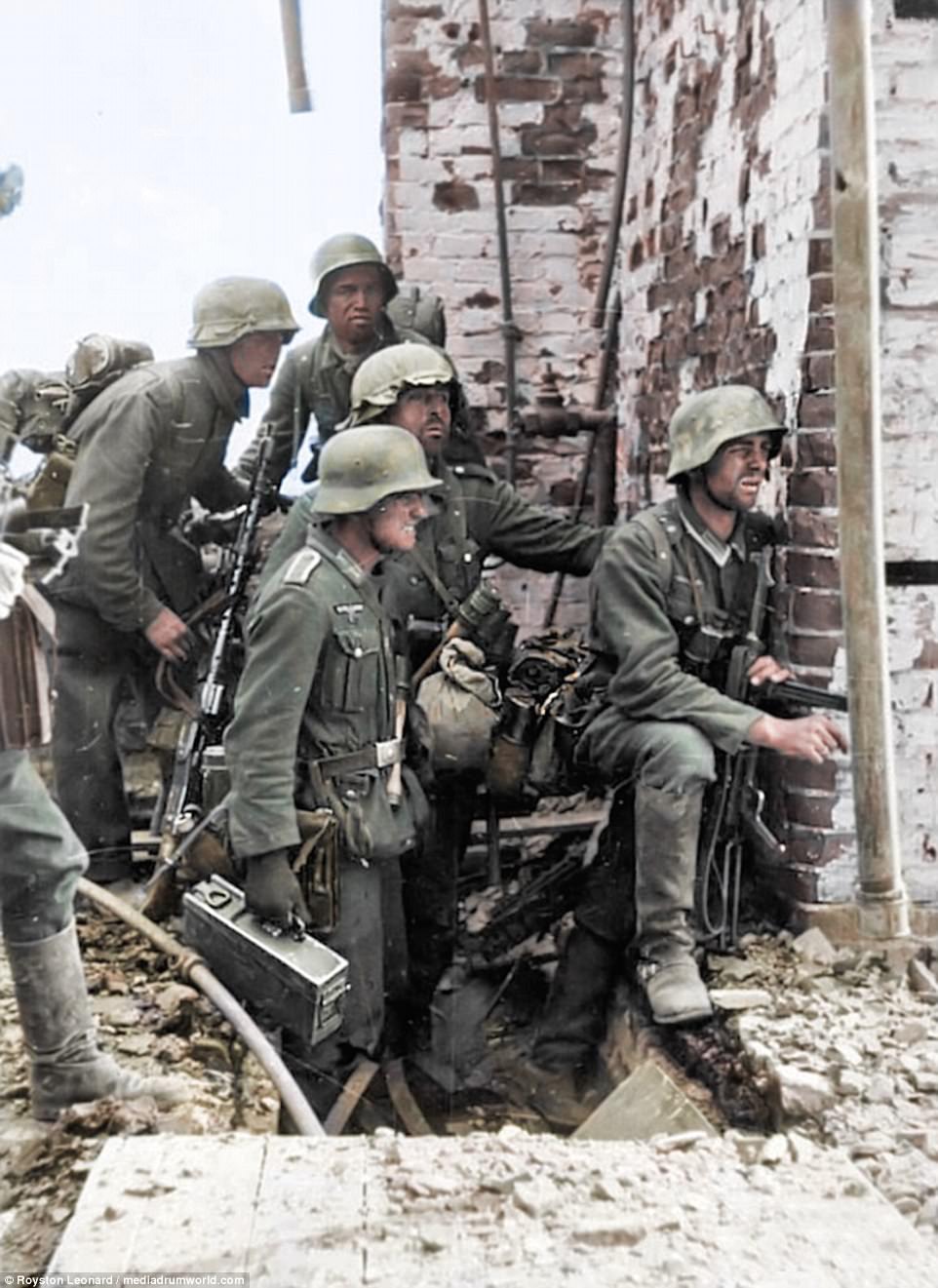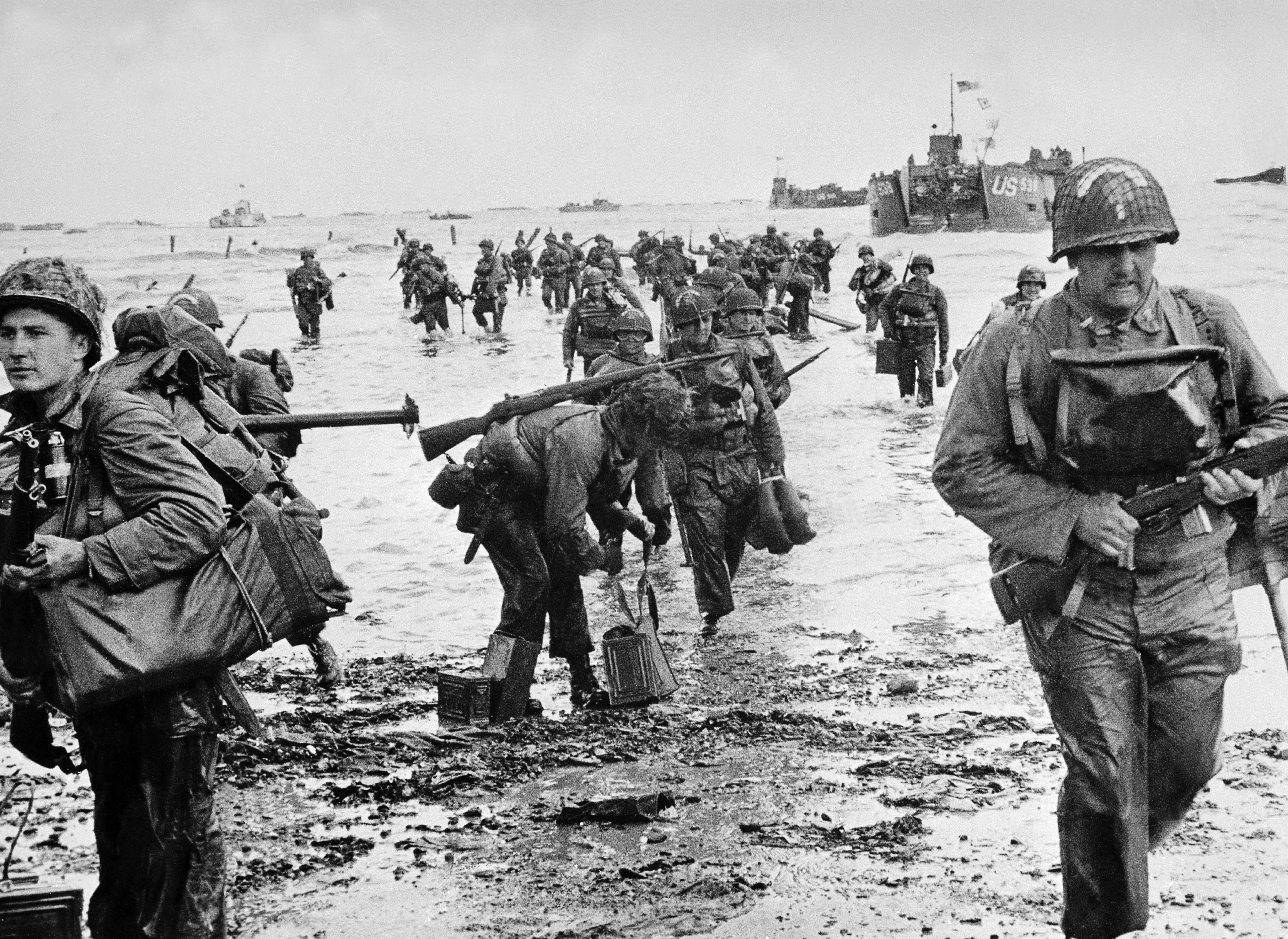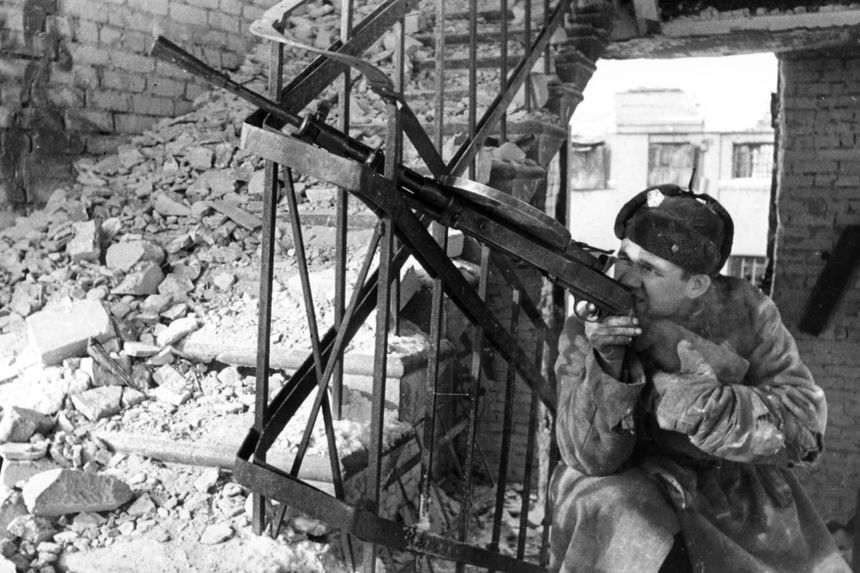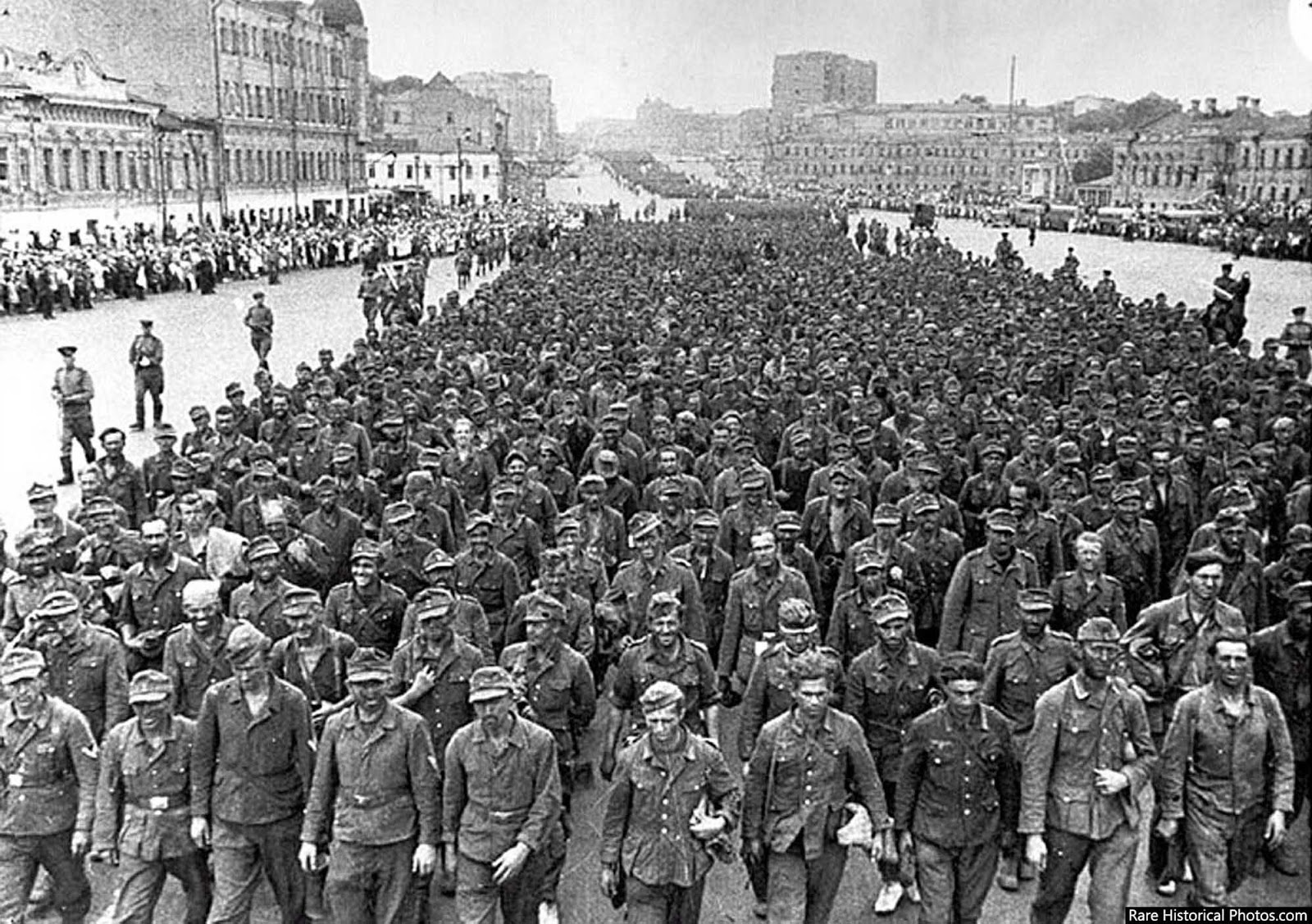
 Jacques Pauwels
Jacques Pauwels

1942: After aerial bombardment has almost totally cleared their path into the city of Stalingrad, German troops make their way through the ruined suburbs. Almost every standing building in Stalingrad served as a firing point for Germans or Soviets, forcing house-to-house combat. (Photo by Keystone/Getty Images)
However, to win the great war planned by Hitler, Germany, a highly industrialized country but lacking colonies and therefore woefully short of strategic raw materials, had to win it fast, before the depletion of the stockpiles of imported rubber and above all petroleum that Germany could establish before the start of the conflict. These reserves, much of which consisted of imports from the US, could not be adequately replenished by synthetic fuel and rubber produced at home (on the basis of coal) and/or oil supplied by friendly or neutral countries such as Romania and – after the Hitler-Stalin Pact of August 1939 – the Soviet Union. It is in this context that the Nazis developed the strategy of Blitzkrieg, “lightning warfare”: synchronized attacks by massive numbers of tanks, airplanes, and trucks (for transporting infantry), piercing the defensive lines behind which the bulk of the enemy’s forces were typically ensconced in the style of World War I, then encircling these forces, leaving them to face either annihilation or capitulation.
From the Ostkrieg, their Blitzkrieg in the east, on what would later be called the “eastern front,” Hitler and his generals expected much more than from their previous lightning campaigns. Their stockpiles of fuel and rubber had already dwindled after their gas-guzzling planes and panzers had embarked on a conquest of Europe from Poland to France via Norway; by the spring of 1941, the remaining supplies of fuel, tires, spare parts, etc. sufficed to wage motorized war for no more than a couple of months. The shortfall could not be compensated by imports from the Soviet Union as part of the Ribbentrop-Molotov Pact of August 1939, as is claimed by some historians. According to a meticulous study by Canadian history professor Brock Millman, published in The Journal of Contemporary History, merely four percent of Germany’s fuel came from Soviet sources. In 1940 and 1941, Germany depended mostly on petroleum imported from two countries: first, Romania, initially a neutral country but an ally of Nazi Germany as of November 1940; second, the United States, whose “oil barons” supplied the Hitler regime with enormous quantities of “liquid gold” via neutral countries such as Franco’s Spain and occupied France; these exports were to continue until the United States entered the war in December 1941. As for the relatively modest imports of Soviet petroleum, they actually troubled Hitler deeply because according to the terms of the 1939 Pact, Germany had to deliver high-quality industrial products and state-of-the-art military technology, used by the Soviets to strengthen their defenses in preparation for a German attack that they expected sooner or later.
While the Red Army took a terrible beating at first, it had not massed its forces at the border but opted for a defense in depth; withdrawing in relatively good order, it managed to elude destruction in one or more of the kind of huge encirclement battles that Hitler and his generals had dreamed of. It is this “defense in depth” that prevented the Wehrmacht from destroying the Red Army, as Marshal Zhukov has emphasized in his memoirs. The Germans advanced, but increasingly slowly and at the price of great losses. By late September, that is, two months after the start of Barbarossa, when victory should have been a fait accompli and the German soldiers ought to have been heading home to be welcomed there as conquering heroes, they were still a very long way from Moscow and even farther from the Caucasian oil fields, a major object of Hitler’s desires in his Ostkrieg. And soon the mud, snow and cold of fall and early winter were to create new difficulties for troops that had never been expected to fight in such conditions.
 Shortly after Germany’s Führer received the bad news from Russia, he learned that the Japanese had attacked Pearl Harbor on December 7 and that the Americans had reacted with a declaration of war against Japan, but not against Germany, which had nothing to do with this attack. However, Hitler himself declared war on the United States, namely on December 11. His alliance with Japan did not require him to do so, as some historians have claimed, because it required to come to the aid of a partner that was attacked by a third country; however, the land of the rising sun was not attacked but had itself initiated the hostilities. With this dramatic gesture of solidarity vis-a-vis his Japanese partner, Hitler undoubtedly hoped that would cause Tokyo to reciprocate and declare war on his own mortal enemy, the Soviet Union. In this case, the Red Army would have to fight a war on two fronts, and this might have revived German prospects for victory in the titanic Ostkrieg. But Japan did not take the bait, and Nazi Germany was thus saddled with another formidable enemy, though it would take a long time before American forces would engage in actual combat against Nazi troops.
Shortly after Germany’s Führer received the bad news from Russia, he learned that the Japanese had attacked Pearl Harbor on December 7 and that the Americans had reacted with a declaration of war against Japan, but not against Germany, which had nothing to do with this attack. However, Hitler himself declared war on the United States, namely on December 11. His alliance with Japan did not require him to do so, as some historians have claimed, because it required to come to the aid of a partner that was attacked by a third country; however, the land of the rising sun was not attacked but had itself initiated the hostilities. With this dramatic gesture of solidarity vis-a-vis his Japanese partner, Hitler undoubtedly hoped that would cause Tokyo to reciprocate and declare war on his own mortal enemy, the Soviet Union. In this case, the Red Army would have to fight a war on two fronts, and this might have revived German prospects for victory in the titanic Ostkrieg. But Japan did not take the bait, and Nazi Germany was thus saddled with another formidable enemy, though it would take a long time before American forces would engage in actual combat against Nazi troops.In the spring of 1942, Hitler scraped together all available forces for an offensive —code-named “Operation Blue” (Unternehmen Blau) – in the direction of the oil fields of the Caucasus. He had convinced himself that he still had a chance of winning the war, but certainly not “if he did not get the petroleum of Maikop and Grozny.” The element of surprise had been lost, however, and the Soviets still disposed of huge masses of men, oil, and other resources. The Wehrmacht, on the other hand, could not compensate for the huge losses it had suffered in 1941 in its “crusade” in the Soviet Union: 6,000 airplanes and more than 3,200 tanks and similar vehicles; and more than 900,000 men had been killed, wounded, or gone missing in action, amounting to almost one-third of the average strength of the German armed forces.4

Claus von Stauffenberg. Wanted to get rid of Hitler and sue for an "honorable peace" with the allies, but the plot failed.
If, after the Battle of Stalingrad, they wanted to get rid of Hitler, it was because they feared that he would drag them with him into ruin. Awareness of the significance of the German defeat on the banks of the Volga similarly demoralized the allies of Nazi Germany and caused them to start looking for ways to exit the war. As for the neutral countries, many of which had hitherto sympathized with Nazi Germany, mostly because their rulers shared Hitler’s anti-Sovietism, they became considerably more benevolent towards the members of the “anti-Hitler coalition,” and above all towards the “Anglo-Americans.” Franco, for example, pretended not to notice the allied airmen whose planes had been shot down over occupied countries and who, assisted by resistance fighters, crossed the Pyrenees from France into Spain to return that way to England.
In France and in other occupied countries, the leading political, military, but also economic collaborators, that is, bankers and industrialists, started to discreetly distance themselves from the Germans. Relying on the benevolent services of the Vatican and the Franco regime, they sought contact with the Americans and the British, from whom they received sympathy and assistance as both sides were eager to preserve the established capitalist social-economic order. (The French historian Annie Lacroix-Riz has focused on this little-known aspect of the war in a couple of her thoroughly researched and documented books.) Conversely, the news from Stalingrad boosted the morale of Germany’s enemies everywhere. After many long years of darkness, when it had seemed that Nazi Germany would dominate all of Europe forever, resistance fighters in France and elsewhere finally perceived the proverbial light at the end of the tunnel. And their ranks were now increasingly reinforced by many who had been too lethargic before they received the happy tidings from Stalingrad. In France, in particular, the name of Stalingrad became a battle cry of the resistance. After the great victory of the Red Army on the banks of the Volga, the specter of an inevitable defeat haunted 6 Germany, while in the occupied countries everybody knew that the hour of liberation approached– slowly, perhaps, but surely.
Let us know consider the post-Stalingrad situation from the viewpoint of Uncle Sam and his British (junior) partner. There is no doubt about it: the prospect of Germany being defeated and of France and the rest of Europe being liberated by the Red Army caused alarm bells to ring in the halls of power in London and Washington. The Western Allies had been happy to remain on the sidelines, minimizing their losses and maximizing their military strength, while the Nazis and Soviets were locked in mortal combat on the Eastern Front. While the Red Army provided the cannon fodder needed to vanquish Germany, they would be able to intervene decisively, like a deus ex machina, whenever the Nazi enemy as well as the unloved Soviet ally would be exhausted. With Britain on its side as a junior partner, the USA would then be able to play the leading role in the camp of the victors and dictate the terms of the peace to the Soviets as well as the Germans. It is for this reason that, in 1942, Washington and London had refused to open a “second front” by landing troops in France. Instead, they had implemented a “southern” strategy by sending an army to North Africa in November 1942 to occupy the French colonies located there. Because of the outcome of the Battle of Stalingrad, the situation had changed dramatically.

Despite the Hollywood hoopla, the D-Day landings had a far less noble purpose than what Anglo-American media, politicians, and historians would admit.
However, when the news of the Soviet triumph at Stalingrad became known and its implications started to sink in, which was in early 1943, it was too late to plan a landing in France for that same year, so things had to wait until the spring of 1944.
As the Second World War came to an end, and for quite a few years afterward, most denizens of Western European countries victimized by Nazi Germany, but France in particular, were keenly aware that the libération of their homeland was above all due to the efforts and sacrifices of the Soviet Union, a fact that had become evident a the time of the Red Army’sglorious victory in the Battle of Stalingrad. It was a period of time when these same people, in stark contrast to the present situation, harboured enormous gratitude and goodwill vis-à-vis the Russians and other ethnic groups – Ukrainians, Georgians, Armenians, Azeris, Uzbeks, etc. – of the Soviet Union. The name given in June 1945 to one of the largest squares in Paris still recalls that distant and brief moment in time: Place de la Bataille-de-Stalingrad, ‘Square of the Battle of Stalingrad.
(Sources are available on request) 9
Print this article
The views expressed herein are solely those of the author and may or may not reflect those of The Greanville Post. However, we do think they are important enough to be transmitted to a wider audience.

Unfortunately, most people take this site for granted.
DONATIONS HAVE ALMOST DRIED UP…
PLEASE send what you can today!
JUST USE THE BUTTON BELOW
| Did you sign up yet for our FREE bulletin? It’s super easy! Sign up to receive our FREE bulletin. Get TGP selections in your mailbox. No obligation of any kind. All addresses secure and never sold or commercialised. [newsletter_form] |
[premium_newsticker id=”211406″]

This work is licensed under a Creative Commons Attribution-NonCommercial 4.0 International License






